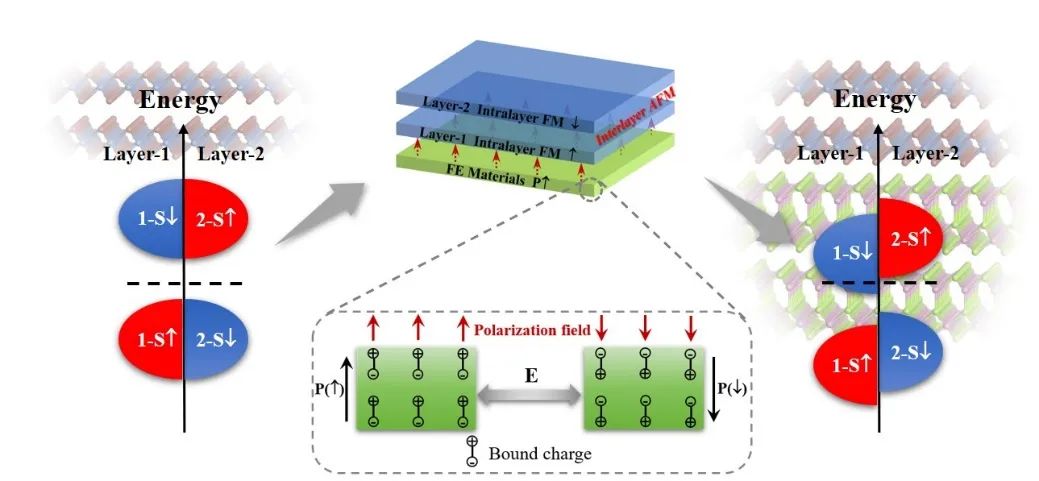海归学者发起的公益学术平台
分享信息,整合资源
交流学术,偶尔风月

反铁磁材料由于具有强抗干扰能力、无杂散场、超快动力学等优点,有望为下一代自旋电子学器件带来革命性的进步。调控实现反铁磁材料的半金属性或产生完全自旋极化的电流是要将反铁磁材料应用于自旋电子学中的关键。由于电场调控具有响应快和低功耗的优点,是人们长期以来调控得到半金属性的常用手段。然而,这种方式所实现的半金属性是易失的,因为当电场撤走后,完全自旋极化的传导电子就会随之消散,这对存储和逻辑器件而言并不是理想的选择。将磁性材料和铁电材料结合在一起的多铁范德华异质结为磁电耦合效应的实现提供了一个很好的平台,也使非易失电控磁成为了可能。

Fig. 1 Principle for realizing
half-metallicity.来自山东大学晶体材料国家重点实验室的赵显教授、李妍璐教授团队和济南大学自旋电子学研究所的李胜世团队设计构建了由二维双层A型反铁磁NiI2 (bi-NiI2)材料与不同厚度的二维铁电In2Se3材料组成的范德瓦尔斯异质结,通过第一性原理预测了与In2Se3双层耦合的bi-NiI2可以实现半金属性的产生与切换。
Fig. 2 Basic properties of bi-NiI2/In2Se3 heterostructure.当bi-In2Se3的铁电极化由向上变为向下时,bi-NiI2会经历从半金属到半导体的转变,这一现象主要是由极化场诱导的能带移动与层间的电荷转移共同作用引起的。与此同时,bi-NiI2的易磁轴会由面内转变为面外。
Fig. 3 MAE of bi-NiI2/bi-In2Se3 heterostructure.既然二者间也有如此“心灵”感应,那么异质结中bi-NiI2的半金属性和磁各向异性就可通过应变来进行有效调控。基于该异质结,作者提出了一种铁电存储器件,其数据读取过程是将铁电层的极化态转变为反铁磁的导电态来进行检测的。
Fig. 4 Device prototype and schematic diagram.
该研究为二维反铁磁材料中非易失性电控半金属性提供了一种切实有效的方法,将极大地推动反铁磁自旋电子学的发展。该文近期发表于npj Computational Materials 8,;218(2022),英文标题与摘要如下,点击左下角“阅读原文”可以自由获取论文PDF。
Switchable half-metallicity in A-type
antiferromagnetic NiI2 bilayer coupled with ferroelectric In2Se3
Yaping Wang, Xinguang Xu, Xian Zhao, Weixiao Ji, Qiang Cao, Shengshi Li & Yanlu Li
Electrically controlled half-metallicity in antiferromagnets is of great significance for both fundamental research and practical application. Here, by constructing van der Waals heterostructures composed of two-dimensional (2D) A-type antiferromagnetic NiI2 bilayer (bi-NiI2) and ferroelectric In2Se3 with different thickness, we propose that the half-metallicity is realizable and switchable in the bi-NiI2 proximate to In2Se3 bilayer (bi-In2Se3). The polarization flipping of the bi-In2Se3 successfully drives transition between half-metal and semiconductor for the bi-NiI2. This intriguing phenomenon is attributed to the joint effect of polarization field induced energy band shift and interfacial charge transfer. Besides, the easy magnetization axis of the bi-NiI2 is also dependent on the polarization direction of the bi-In2Se3. The half-metallicity and magnetic anisotropy energy of the bi-NiI2 in heterostructure can be effectively manipulated by strain. These findings provide not only a feasible strategy to achieve and control half-metallicity in 2D antiferromagnets, but also a promising candidate to design advanced nanodevices.